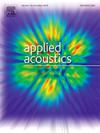Addressing modelling errors in feedforward ANC systems: A new normalised semi-variable step size FxLMS algorithm
IF 3.4
2区 物理与天体物理
Q1 ACOUSTICS
引用次数: 0
Abstract
Despite the potential of active noise control (ANC) technology, its full utilisation remains a subject of ongoing research, particularly for environments as critical as intensive care units (ICUs), where noise reduction is an overwhelming and pressing concern. Conventional ANC systems, employing filtered-x least mean square (FxLMS) based algorithms, often face challenges balancing convergence speed and achievable noise attenuation, especially in high-noise settings like ICUs. To address this challenge and enhance the performance of ANC systems in noisy environments, the normalised semi-variable step size filtered-x LMS (NSVSS-FxLMS) algorithm is proposed in this paper. The step size of the proposed algorithm is changing corresponding to the power ratio of the primary input noise and desired signals modelling error, and the norm squared of the filter weight vector. Since the power ratio is not available directly, an indirect approach is used to track its variations using a hyperbolic function. This enables the algorithm to achieve a rapid initial convergence and then to smoothly transition for minor adjustments, thereby maintaining an adaptive steady state which could significantly improve the performance of the ANC system. Comparative analysis, conducted using narrowband and broadband noise signals recorded in ICUs and impulsive noise, illustrates the potential of the proposed adaptive algorithm against the existing fixed-step algorithms. The results demonstrate not only superior noise reduction but also improved convergence speed, indicating a potential for advancement in addressing noise challenges within ICUs.
求助全文
约1分钟内获得全文
求助全文
来源期刊

Applied Acoustics
物理-声学
CiteScore
7.40
自引率
11.80%
发文量
618
审稿时长
7.5 months
期刊介绍:
Since its launch in 1968, Applied Acoustics has been publishing high quality research papers providing state-of-the-art coverage of research findings for engineers and scientists involved in applications of acoustics in the widest sense.
Applied Acoustics looks not only at recent developments in the understanding of acoustics but also at ways of exploiting that understanding. The Journal aims to encourage the exchange of practical experience through publication and in so doing creates a fund of technological information that can be used for solving related problems. The presentation of information in graphical or tabular form is especially encouraged. If a report of a mathematical development is a necessary part of a paper it is important to ensure that it is there only as an integral part of a practical solution to a problem and is supported by data. Applied Acoustics encourages the exchange of practical experience in the following ways: • Complete Papers • Short Technical Notes • Review Articles; and thereby provides a wealth of technological information that can be used to solve related problems.
Manuscripts that address all fields of applications of acoustics ranging from medicine and NDT to the environment and buildings are welcome.
 求助内容:
求助内容: 应助结果提醒方式:
应助结果提醒方式:


